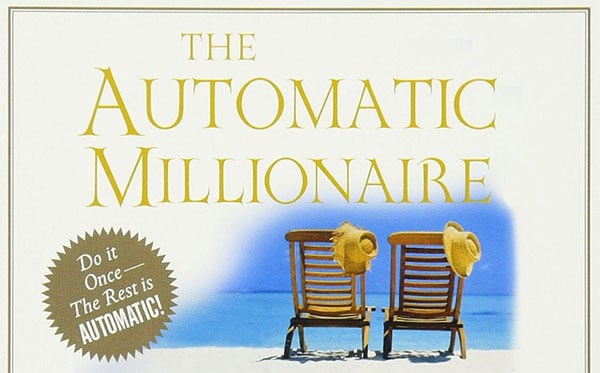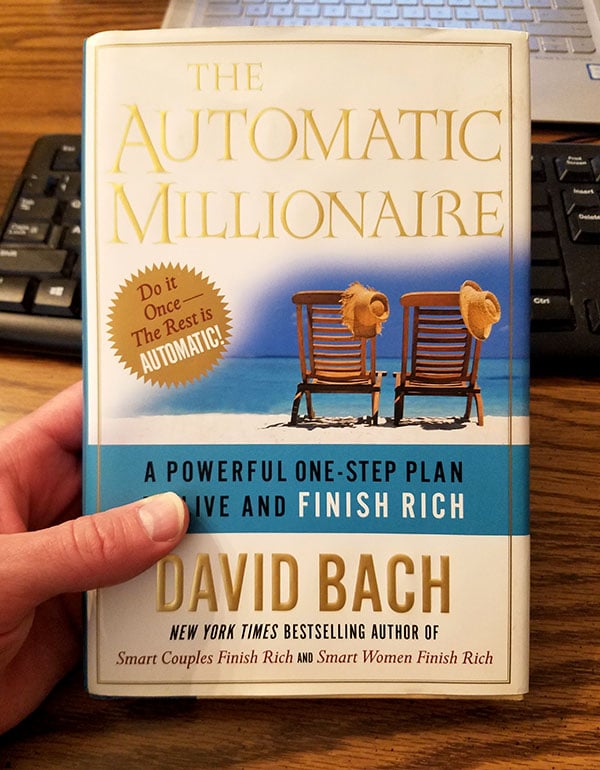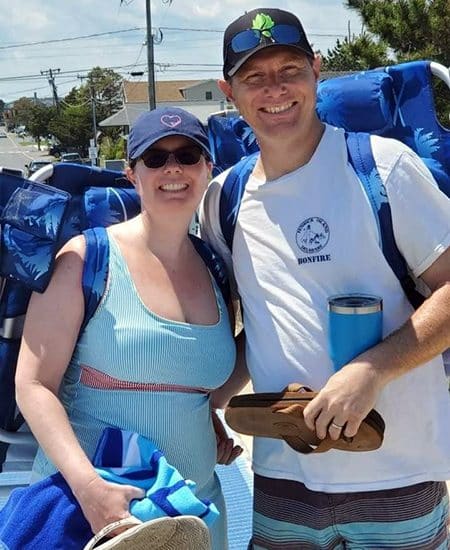Looking for “The Automatic Millionaire” summary? Here’s a one-page cheat sheet for yousummarizing the classic personal finance book.
If you’ve never read the classic $$$ book, “The Automatic Millionaire” by David Bach, today you luck out and get a cheat sheet on it to tide you over until you wise up ;)
The winner of it from our giveaway just emailed me saying she devoured it in two days and it’s now one of her top 3 favorite finance books (as it is mine!), and then proceeded to tell me she’s making a one-pager summarizing everything to pass around to friends. As soon as I heard that I of course asked if I could grab a copy too to pass around to everyone, and now here we are with her Cliffs Notes!
You can download a PDF of it here if you want to print out and share too — Automatic Millionaire Summary – but below you’ll find her notes for an even quicker gander.
Thanks for paying it forward, Rachael! A great refresher for all of us whether we’ve read it already or not!
(The “personal notes” listed below are hers, not mine)
*********
“The Automatic Millionaire” Summary
By David Bach
(2004 edition)
In this The Automatic Millionaire Summary, there are several key takeaways:
Automate everything that you can!
It takes the decision-making process out of your hands after that and you don’t have to depend on willpower or memory to keep it up.
Pay yourself first
Anything that you can is better than nothing at all. Start at 1% if you have to.The rich save 20% or more of their gross income, if you want a goal to aim for. Suggested contribution of savings: 10%. Arrange to have your savings pulled out of your paycheck and put into a 401K or IRA, etc. Make sure this is automatic.
Your Latte Factor is the number that we unknowingly spend on a daily basis that could be reduced or eliminated altogether
Maybe you do get a daily coffee before work, or eat lunches out, or get a magazine subscription? All these things need to be slimmed down according to The Automatic Millionaire summary.
(Personal note: though I’ve never found this to apply directly to me, I am participating in the ‘no spend year’ challenge, and even I found that I can save about $2k this year by not spending any money at all on fun wants. Going forward, then, into next year when I do resume spending again, I hope to continue to save at least $1,000 of that excess money and I’ll still have $1,000 to spend on my own desires throughout the year. This includes everything from coffee, eating out, buying gifts for others, and vacations, etc. I’m fairly frugal anyway, so I should be able to make this work without too much trouble. Obviously I won’t be able to go on vacation every year though! :P)
Automate a ‘rainy day’/emergency fund
Do this for yourself with enough money to let you sleep well at night (between 3-24 months of expenses). This should go in a money market account and/or US savings bonds. Suggested contribution of savings: 5%.
Become a home-owner to invest in your future
Automate half-payments to be paid every two weeks rather than once a month. This may seem like the same amount, but in reality you will ‘sneak in’ an extra house payment each year and can pay off your house about seven years faster just by doing this one thing.
Automate debt-payments, if you have any
If you are paying yourself that 10% first, as suggested above, save half of it for your retirement, and put the other 5% towards reducing your debt. This way you can accomplish both goals at the same time. And stop getting further into debt! This may be a no-brainer, but don’t sabotage yourself, please. You’re working too hard for this! (Check out his book for the DOLP system* to know how he recommends paying off debt.)
Automate giving/tithing
Become an even more generous person with your resources. (Personal note: I automate my giving to Compassion International, Kiva, and to my church. This can be done regardless of the organization, it seems. If you’re not sure, just check with them!)
The Main Takeaway of The Automatic Millionaire Summary
So basically the takeaway from The Automatic Millionaire summary is automate, automate, buy a house, automate, and then automate some more ;) Though of course we all have our opinions on that home one…
Still, a pretty direct book that will indeed get you your first million if you’re committed enough to follow through. It won’t happen overnight, but time and compounding do magical things when you leave stuff alone, and you can always tweak the %’s upward if you find you’re getting impatient too.
This stuff isn’t that complicated!!
To pick up the book in its entirety you can visit Amazon – The Automatic Millionaire: A Powerful One-Step Plan to Live and Finish Rich, or you can continue cheating by reading my personal review of it all the way back in 2008 when I was starting my own journey:
I think you can guess on how that one ended ;)
Happy automating!!
——–
*DOLP stands for Dead On Last Payment (pay off credit cards, close accounts). Bach’s system describes how to assign each debt a number, and basically snowball your way through paying them off. It’s a little different I believe than the Dave Ramsey system, but that’s the basic idea.
** Amazon links above are affiliate links
Get blog posts automatically emailed to you!






This is awesome, Rachel and J! Love the automation. Not only does it take your mind off decision making, but it resets your default mode to be more in line with your goals and values.
I’m also doing a “No-Spend” challenge this new year. I’m tracking “no-spend” days in a daily planner. For me, the definition of a no-spend day is one where I spend no money (on needs or on wants). My goal is 50% no-spend days per month (not too extreme, but still pretty tough).
What is most interesting to me about a “no-spend” challenge is that, like automation, it resets your default spending habits/decisions to “no-spend”. Should I buy x, y or z? During a no-spend challenge, the default answer to all spending temptations is “no”, which means I have to exercise an awful lot of thought when I do make a purchase decision. I’m finding it incredibly fruitful, and fun, so far.
Leah, as February starts soon, I’m getting ready to begin a no-spend month. That means only needs, like milk (some people suggest buying in quantity and freezing it, but I HATE frozen, thawed out milk), fresh veggies/fruit, and medical co-pays. You get the idea. I like how you’re tracking your no-spend days! Last time I did this I made some huge discoveries about myself, and found that some needs are really, truly, just wants. Yes, I CAN survive when I run out of my fav flavored coffee creamer. No-spend month is a very serious endeavor for me as it points out in glaring detail my not so great habits, yet gives me an opportunity to grow my money-handling skills.
I can’t wait to hear how you progress as the year wears on; I specifically do a month so I can evaluate and then decide when I can do it again. Cheers girl!!!
I LOVE YOU BOTH SO MUCH!!!
Will you both come back to let me know how it goes, please?! :)
I’ve never tried a literal no spend day/month before, but I kinda like the twist… Similar to drinking I find it’s much easier to just do completely without than tempt yourself with exceptions :)
Thanks, J! I’ll let you know how it goes. :)
Stephanie – awesome! I hope it’s helpful for you. There’s something very liberating about a “no spend” month. I’ve done 6-8 “no spend” months in the past where I’ve tried to cut everything except “essentials”. It definitely helped, but I also found I expended a lot of mental energy deciding what was essential, and then rationalizing things that were on the borderline. I also didn’t really track my spending either, so although I saw positive results overall, it didn’t change my behavior long term. For this year, I’m tracking in my planner every night what I’ve spent that day, and aiming for 50% no spend days a month means I don’t have to rationalize quite so much – I’ve either spent money or I haven’t. It’s cleaner for me, and I feel more accountable and can celebrate the win of a no-spend day when I mark my planner at the end of the day. I’m still early into the challenge, but I’m definitely finding it fruitful so far. It’s like a game, and it makes turning down those extra/mindless cups of coffee, ice cream (boo!), dining out, or whatever worth it.
Nice list! One important caveat: You can’t just decide to send your mortgage payment like that. Your mortgage company has to allow it. It’s a great tip, but it does require checking to see that they allow it. Some, realizing what a great tip it is, charge you to set it up to do it, and some don’t allow it at all.
You can get the same result with either sending one extra payment per year (great use of a tax refund) or if that feels too big. Take the amount of one months payment, divide by 12, and add that to each month. (If your payment is $1200 / send $1300 instead. $1200 pmt/12 = $100 -> add $1200 pmt plus1/12th and send $1300).
All have the same effect.
I read this book more than a decade ago when I was starting my personal finance journey. I still automate many things, especially savings. I also went to a couple of David Bach’s seminars and learnt a lot. One thing I have not done though, is to be a home owner here in the US as I relocate internationally every few years. However, I have property in my home country whose value has continued increasing faster than I expected.
And that’s perfectly okay!! Owning is NOT for everyone, and even for those who can afford it (like those who prefer to invest in other places instead). It’s all about finding your own comfort levels and then being strong enough to stick to them :)
Thanks for sharing this. I’ve been meaning to read this book for quite some time. I’ll move it up the list a little bit.
oh good! i hope you do!
Nice quick and dirty list for anyone needing to learn the basics of financial independence, particularly those resistant to learning or not wanting to invest much time in reading about it.